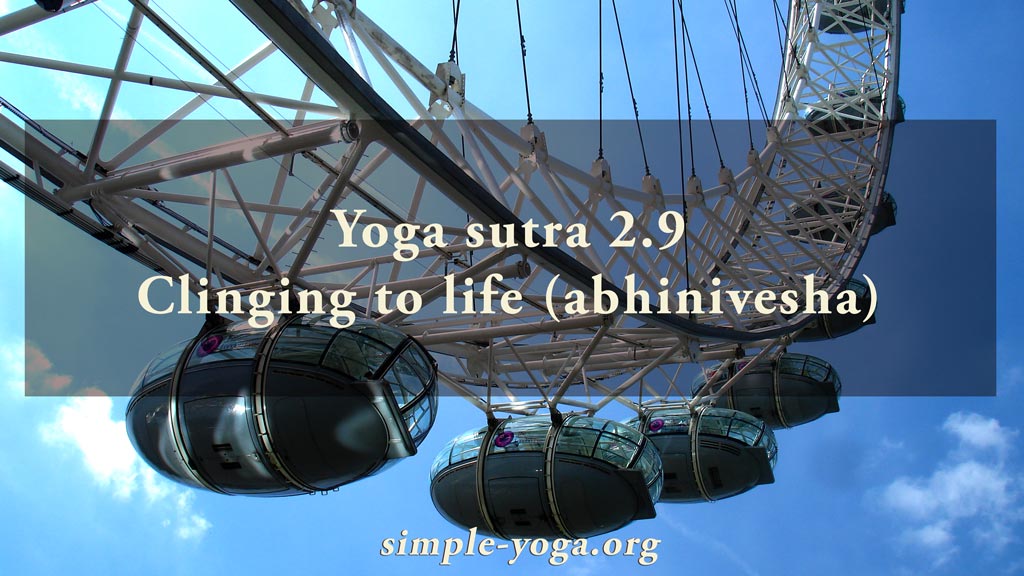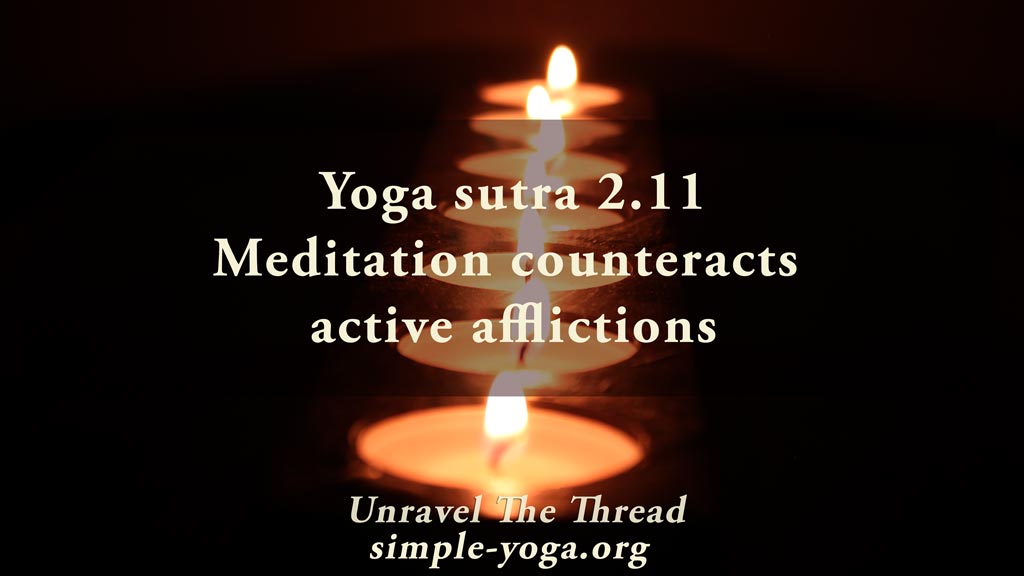
2.9 Clinging to life
May 3, 2020
2.11 Meditation counteracts active afflictions
May 16, 2020
2.9 Clinging to life
May 3, 2020
2.11 Meditation counteracts active afflictions
May 16, 20202.10 Dissolving subtle afflictions

2.10 Subtle afflictions dissolve when the sense of being merges into pure awareness.
In Chapter One of the Yoga Sutra, Patañjali offered a definition of yoga followed by a list of the ways of being that keep us from embodying presence. Then, Patañjali suggested a method to regulate our ways of being. In this chapter Patañjali follows a similar logic. First, he gives the definition of yogic action with its goals, followed by a list of the sources of pain that can be removed through those actions. Verse 2.4 continues by saying that all these sources of suffering listed in sutra 2.3 originate in not remembering who you are and that these afflictions exist in varying levels of manifestation from dormant to fully active. The chapter continues by suggesting ways to regulate those sources of affliction. These five sources of suffering (klesha) in 2.3 are present throughout your day, at least to some extent. When you drop all your stories, opinions and ideas about who you are, – as well as who you used to be or who you should be – all of these afflictions dissolve. This is what happens when you are in deep sleep. In order to sleep you must release your worries, plans and to-do lists. Once you let go of what you do not need, you fall asleep and there is no notion of inside and outside, I and other. During sleep the grip of self-centeredness, likes, dislikes, and self-importance softens. During dreaming some of those afflictions are still active as the subconscious mind tries to make sense of all of them. In dreamless deep sleep the afflictions dissolve. At the most fundamental level, not being clear on who you are, that is, misidentification with what is temporary, is the source of the challenges that most of us face. Verses 2.10 and 2.11 present two ways of dealing with these afflictions.
As mentioned in sutra 2.2, yogic actions decrease afflictions. Sutra 2.3 enumerated the different states of the afflictions: dormant, weak, intermittent and active. This sutra proposes a way for removing the afflictions that have been diminished to a subtle level of manifestation. This deactivation process is called involution (pratiprasava). Involution refers to reversing the process of evolution of the afflictions. Combining the ideas in 1.3 and 1.4 with those in sutras 2.3 to 2.9 helps to understand this process better. In your natural state (1.3) there is no misidentification with your sensations and perceptions (1.4). The misidentification is forgetting your own nature (avidya in 2.4 and 2.5). Misidentification results in developing a sense of “I” as separate from the rest of existence (asmita in 2.6). Consequently, the sense of “I” develops preferences in the form of likes (raga 2.7) and dislikes (dvesha 2.8). Entangled in the sense of self and its preferences, a sense of self-importance grows generating attachment to embodied experiences and fear of dying (abhinivesha 2.9).
Remember that the process of yoga is an invitation to observe yourself as clearly as possible, including observing your responses to everything that comes your way. These observations are likely to reveal some patterns (citta vrtti – your ways of being) in your body, breath, mind, emotions, actions and interactions. Then, you can choose to keep the ways of being that are supportive of being present and discard the unhelpful patterns, if even just for a few moments. Similarly, observing your patterns of thought, emotion, action and interaction can help you notice how the five afflictions may be underlying the patterns you observe. The first step in the involution process is to turn around the development of self-importance that manifests as clinging to life (abhinivesha). For instance, every time that you notice your opinions, either internally or externally, you may ask yourself: “Who cares about my opinions? You can also reflect on the extent to which you offer your opinion to support your perceived authority and position. It was mentioned before that feeling that we are busy with many responsibilities can be one way of feeling important. Often, this can manifest as feeling that you are indispensable, and that the world will stop if you are not handling or managing some situation or project. Does that happen with you? Similarly, is it possible that believing that you can control the world outside betrays an undercurrent of self-importance?
The second stage in this process of involution is to notice your relationship with your likes (raga) and dislikes (dvesha). By observing what you favor as well as what you avoid, you can see the deeper connections between what you grasp and some part of your sense of self linked to that grasping and holding. What are the thoughts, emotions, movements, activities and interactions you favor? Which ones do you avoid or reject? What are the roots of your preferences? Can you clarify why you seem to like some things? Can you notice any patterns in what you dislike?
Another effective practice consists of investigating what you dislike by sitting in a comfortable and relaxed way, closing your eyes and summoning a recent event that caused you minor discomfort, embarrassment or uneasiness. As you feel this tolerable discomfort, you will likely notice a tendency to generate stories, opinions and excuses or an inclination to ignore, reject or try to solve the “problem.” You may choose instead to be curious about just feeling the sensations that emerge. This can be a powerful way of understanding yourself while also releasing some of the accumulated impressions and drama that most of us carry with us. This simple practice can deliver insight into your own ways of being and the triggers that generate reactivity. This insight can offer you a simple and effective way to deactivate some of those triggers.
The third stage is to gain greater clarity on who you think you are (asmita). Remember that contemplating the questions “Who do you think you are?” and “What is important to me?” offer you ways to explore your sense of identity. Each one of us develops an identity according to our upbringing, family, education and society. Our identity manifests as the filters we use to interpret and relate to ourselves, to the people around us, to institutions and to the society that we participate in. Although we may think that our identity is quite fixed, our identity, like almost everything about us, is a work in progress, with some aspects of it changing all the time. For instance, for the person who derives a large portion of his identity from his occupation, losing his job can trigger an existential crisis, partly because he will be forced to modify his sense of identity. Just like losing one’s possessions feels devastating for the person who believes that her material possessions make her who she is. In some of those cases the dramatic change of being forced to confronting these deeply held beliefs can generate a deep personal transformation.
A useful line of contemplation includes determining what makes you who you are. Then try to connect to who you were before, when your circumstances and situation were different. You may also imagine what would happen if your situation changed and some of the things that define you were to suddenly disappear. Notice any changes in your internal emotional environment. This inquiry can be expanded to explore the fears and anxieties that you may have. To what extent do your fears relate to who you think you are or should be? These fears and anxieties may also be connected to what you think other people expect or think of you and of your actions. Additionally, our ideas often seem to play a major role in our sense of who we are. Yet, it can be an excellent opportunity for reflection to try to uncover the origin of some of those ideas. It is surprising how many of “our” ideas may not have originated in us. Finally, is it possible that most of your sense of identity dissolves at the end of each day, with only faint traces remaining in your subconscious?
The last stage in this involution process is best summarized in the question: “What is my true nature?” In this stage you try to connect to the basic essence of your being, I AM. This approach was hinted at in the commentary on verse 1.35. One way of practicing is to sit in stillness with comfortable stability repeating silently, I AM, I AM, I AM, I AM, without trying to comment or generate stories, returning again and again to this most essential statement about you. During these explorations, be curious to notice how your usual distractions and internal stories may relate to your sense of identity. One more question to ponder: What is the subtlest aspect of you?
As usual, one more way of exploring the meaning of this sutra is by chanting it.
You can choose to chant it in its traditional form with some of the words coming together:
2.10 te pratiprasavaheyāḥ sūkṣmāḥ
ते प्रतिप्रसवहेयाः सूक्ष्माः ॥१०॥
Another option is to chant each word in the sutra individually:
- te
- pratiprasava
- heyāḥ
- sūkṣmāḥ
If you prefer, you may listen to the podcast:
Unravel the thread is now available as a book!
If you find Simple-Yoga.org and Unravel the thread useful, consider supporting my labor with a donation, you may also donate using PayPal or Venmo. Thank you!
